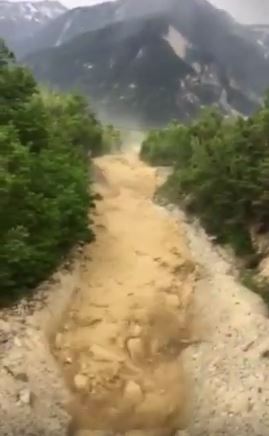31 May 2017
Illgraben – another dramatic debris flow video
Posted by Dave Petley
Illgraben catchment – another dramatic debris flow video
In July last year I posted a video of a very violent debris flow video from the Illgraben catchment, located near to the near the village of Susten (Leuk), in Canton Valais, Switzerland. As I noted at the time, the Illgraben catchment is particularly interesting because it generates a large number of debris flows, some of which are very large. Since 2000 WSL has been using Illgraben as a monitoring site for debris flows. They have installed instrumentation in the catchment and in the debris flow channel. Not surprisingly, cameras are a part of the set-up, meaning that several large debris flows have been recorded. WSL has also built a warning system for the catchment in order to protect the local population. The 2016 debris flow was so large that it damaged much of the scientific instrumentation.
It appears that on 29th May 2017 another enormous debris flow occurred in the Illgraben catchment. The video has been posted to Youtube by RRR Oberwallis:
.
As the image below shows, this is a flow that is characterised by a front with huge blocks:-

Still from a Youtube video of the 29th May 2017 debris flow at the Illgraben site in Switzerland
.
This video was also captured from a distance:
.
And the latter part of the flow from the side (this is not a recommended place to stand!):-
.
20 Minutes has an article (in French) about the event. a rough translation is as follows:-
Thousands of tons of mud ploughed its way through the Illgraben, one of the most active basins of the Swiss Alps, in the area of torrential debris. Within a few seconds, the torrential debris reached the bridge from which the reader Beat Kellenberger filmed the spectacle of nature. “A quarter of an hour before, there were already heavy noises,” explains the Swiss man, who said that these avalanches of water, fine sediments and rock are triggered once or twice a year in this region of Haut- Valais.
The early weekend torrents were caused by a combination of thunderstorms, rain and meltwater, writes the Institute for the Study of Snow and Avalanche (SLF). They added that the mass had flowed into the Rhone and that the inhabitants of the region had been warned in time. According to estimates by the SLF, a volume of about 75,000 cubic meters was discharged Monday in the Illgraben basin, the equivalent of 25 Olympic swimming pools.


 Dave Petley is the Vice-Chancellor of the University of Hull in the United Kingdom. His blog provides commentary and analysis of landslide events occurring worldwide, including the landslides themselves, latest research, and conferences and meetings.
Dave Petley is the Vice-Chancellor of the University of Hull in the United Kingdom. His blog provides commentary and analysis of landslide events occurring worldwide, including the landslides themselves, latest research, and conferences and meetings.